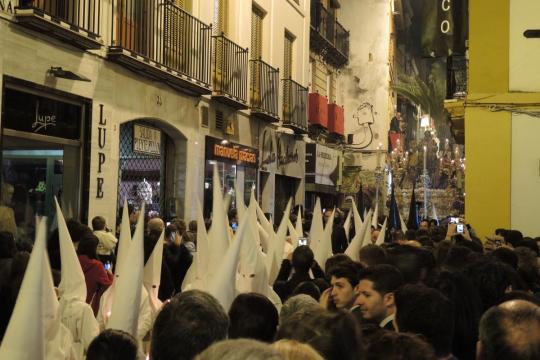Ronda, an ancient striking hilltop city of just under 35,000 people in Andalucia, in the south of Spain, has its own tradition of Holy Week processions marking the Passion of Jesus, dating back to the mid-16th century, less than 100 years after the city was recaptured from Muslim control.
Though not carried out on as grand a scale as in Seville, the Holy Week processions are, given the proportionate sizes of the cities, as significant as in Seville. Ronda even has its own stylistic “school” of design for the images and pasos, the elaborate, carried platforms that bear the images. In 2016 there were 13 Holy Week processions in Ronda, including the one featured here, that of the Hermandad de Santisimo Cristo de la Sangre y Nuestra Señora del Mayor Dolor, the Brotherhood of the Blood of the Most Holy Christ and of Our Lady of Great Sorrows, commonly known as El Silencio, or the Hermandad del Silencio, the Brotherhood of Silence. The confraternity dates to the 16th century, but was refounded in 1947, at the beginning of a period of revival and growth of confraternities.
The images and videos here don’t provide a full accounting of Holy Week in Ronda but do allow a glimpse into the activities of the confraternity both inside the church, as it prepares to process, and in the streets. 1 El Silencio is headquartered in Santa Maria la Mayor (St. Mary Major) church, in the oldest part of the city. It processes on Wednesday night from 11 p.m. to 3 a.m. By 9 p.m., confraternity members arrive at the chapel, having walked from their homes silently in their robes, often with family members. They gather in the chapel for a brief address by their leader and a Mass, open only to members of that confraternity and their families. Inside the chapel, the hours beforehand are a mix of ordinary, low-key preparation and devotion. Members gather and share warm greetings, prepare for their particular roles, take photos, listen to the confraternity director and celebrated Mass together. A few participants cry as they see the paso brought before them.
Just before 11 p.m., the paso is brought outside and the processants line up. At 11, the captain knocks three times and a huge curtain is drawn to show the paso and to begin the procession. Unlike most other processions, the Hermandad del Silencio’s procession is largely silent, and is often said to be the most intense of the week. A few drums or horns launch different stages of the procession, but generally there is no musical accompaniment. The only “music” is the sound of chains, affixed to barefoot penitent’s ankles, dragging along the cobblestones, as they process from the old city over the bridge into the new, for a four-hour procession.
- 1The images and commentary on the Holy Week in Ronda are based on observation as and interviews conducted during Holy Week of 2016. Special thanks to the Hermandad del Silencio for providing the opportunity to witness and film the events in the church before the procession.






















